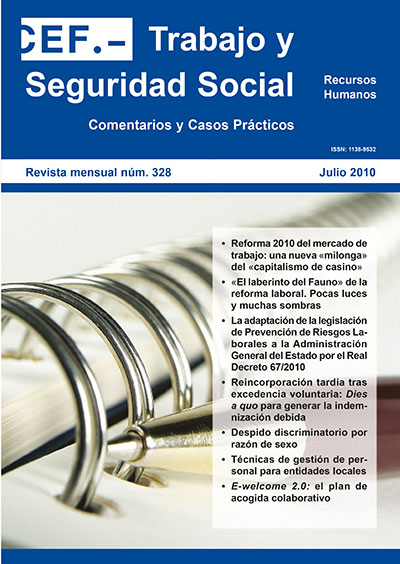Reforma 2010 del mercado de trabajo: una nueva «milonga» del «capitalismo de casino»
DOI:
https://doi.org/10.51302/rtss.2010.5269Palabras clave:
mercado de trabajo, políticas de empleo, crisis económicas, despidos económicos, agencias privadas de colocación, contratos laboralesResumen
El Gobierno se ha decidido a introducir una reforma laboral, a través del Real Decreto Ley 10/2010, ante las presiones de los mercados financieros, los socios de la Unión Europea y el fracaso del Diálogo Social. En esta norma se modifican tres instituciones jurídico-laborales: el sistema de contratación, los despidos y las políticas activas de empleo. Aunque el Gobierno trata de reflejar cambios equilibrados, de modo que no sólo se reduzcan los costes laborales y se incrementen los poderes del empresario, en detrimento de los poderes de los trabajadores y del déficit público, la verdad es que la reforma introduce cambios orientados hacia una mayor flexibilidad en la gestión de la mano de obra.
La reforma aquí comentada es no sólo parcial, y a menudo incoherente, sino provisional, pues será sustituida en breve por una ley, que probablemente cambie un buen número de aspectos del real decreto-ley. No obstante, la importancia de algunas modificaciones legislativas exige un comentario detenido de las mismas, aportando no sólo un mapa preciso de las novedades legales, sino también soluciones a los muchos problemas prácticos que presenta. Por supuesto, sin dejar de lado el enfoque crítico, en la medida en que el autor de este trabajo sostiene que ninguna de las medidas que se han aportado servirá para cumplir ninguno de los dos objetivos buscados: crear empleo y de más calidad, de un lado, y aumentar la productividad de las empresas españolas, de otro. De ahí que entienda que estamos, en gran medida, ante una «milonga», ante la aportación de soluciones que desvían la atención de los verdaderos problemas y de las soluciones realmente eficaces.


















